Joan Brown completes her Master’s degree
On July 22, 2016, Joan Brown, Quwqumalwut, pictured here with her husband Jerry Brown, Hyumulh, successfully defended her MA thesis in Indigenous Education and Linguistics at the University of Victoria. Her thesis, featuring canoe culture, is called “Culture is lived, Language gives it life.”
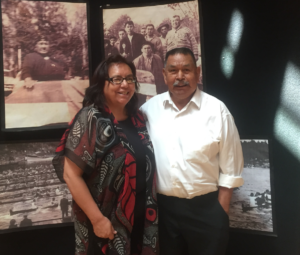
One of the concepts brought out in Joan’s work is “paddling on both sides of the canoe”, which is her way of saying that in moving ahead on language programming, it is good to make use of indigenous ways of knowing as well as research methods from academia. In keeping with this theme, the defense was a blend of two cultural traditions.
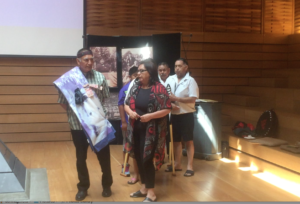
Held in the Ceremonial Hall of the First Peoples House, the event was opened in the Hul’q’umi’num’ language by ceremonial speaker Wayne Charlie, Pulxwuletse’, who called four witnesses.
Next the Chair of the Oral Examination, Dr. Stephen Tax, Peter B. Gustavson School Business, called upon Joan to give a short presentation summarizing her methods and results.
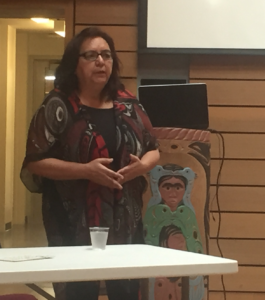
Questioning followed by external examiner, Dr. Helen Raptis, Department of Curriculum and Instruction, and her supervisory commitee, Dr. Donna Gerdts, Simon Fraser University, Dr, Dorothy Kennedy, and Dr. Peter Jacobs.

After two rounds of questions, the floor was opened up to the audience for their comments and questions.
Many of Joan’s family members and other members of Snuneymuxw First Nation were in attendance. A meal was provided by Nancy Seward, SFN Education Coordinator.
The witnesses and family members made speeches.
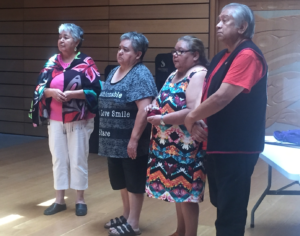
(Pictured are Joan’s sisters Penny Seward, Amy Wyse, and Mandy Jones, and her cousin Bill White).
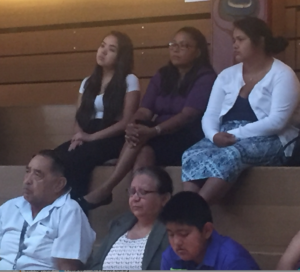
There were three generations of Joan’s family at the defense. Kira Jones, granddaughter, Anna Wyse and her daughter Casey Wyse, and grandson Memphis Wyse were some of the young people in attendance. Also pictured are Collette Jones and Andy Jones.
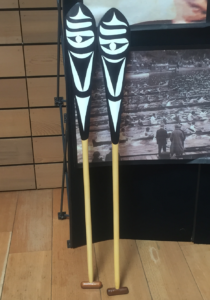 Joan presented paddles made by Len Morris and painted by Noel Brown to the committee and IED graduate secretary CJ Bungay.
Joan presented paddles made by Len Morris and painted by Noel Brown to the committee and IED graduate secretary CJ Bungay.
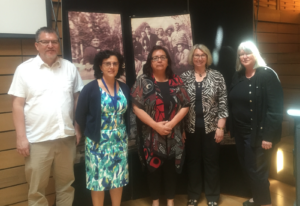
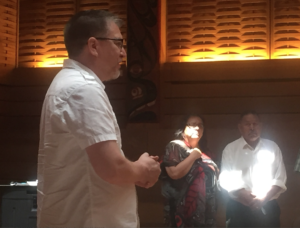
The chair of Joan’s supervisory committee, Dr. Peter Jacobs, thanked the speaker and thanked Joan for the gifts on behalf of the committee, speaking in his own language, Sḵwx̱wú7mesh.
Here is the abstract for the thesis.
_______________
Culture is lived; language gives it life.
The purpose of this study is two-fold; first and foremost, it is an attempt to understand the Coast Salish preferred way of learning by developing a framework that is consistent with a Coast Salish worldview, especially underlying beliefs and assumptions. Secondly, the study will consider this unique learning model’s potential to accelerate and enhance language learning in the Snuneymuxw community. These Coast Salish Ancestral ideas and thoughts will be best understood in the context of canoe racing, a popular Coast Salish event. More importantly, this canoe learning model will help us understand that, like other Indigenous education models, learning progresses and evolves through a sacred process that is reliant on two domains. That is, our learning model is entrenched in two separate but mutually supporting worlds; a spiritual world and a physical world. As I will demonstrate in this study, this foundational principle necessitates a preference to use a whole-system approach to education, especially as it relates to adults learning Hul’q’umi’num’, our own language, as a second language or Indigenous Adult Language Learning (IALL).
